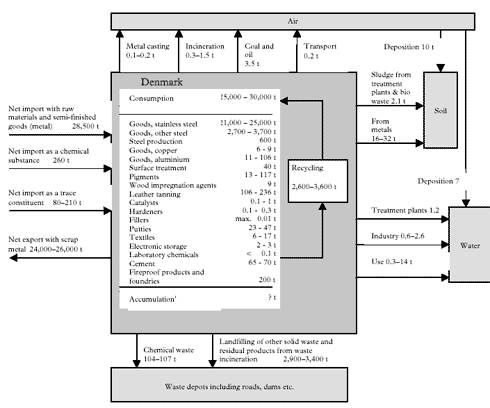|
Mass Flow Analysis of Chromium and Chromium Compounds 6 Overall assessment6.1 Chromium consumption in Denmark, 19996.1.1 Net import of chromium and chromium compoundsChromium and chromium compounds are imported with goods, raw materials and semi-finished goods (metals) as a chemical substance and as a trace constituent. The net import of chromium as a trace constituent/alloy metal in stainless steel, ferrous chromium, steel and iron has been calculated to be 23,200–28,500 tonnes. The net import of chromium as a trace constituent/alloy metal in aluminium and copper is 11–106 tonnes and 6–9 tonnes, respectively. Chromium compounds are primarily imported in the form of chromium oxides, but also in the form of chromium hydroxides, chromium(III) sulphate, sodium dichromate and other dichromates. The total quantity of imported chromium compounds has been calculated to be 260 tonnes, of which chromium(VI) accounts for approximately 110 tonnes. In addition to this, chromium is also imported as a trace constituent/impurity in a number of products. The most significant of these are fossil fuels (coal and oil, accounting for 147 tonnes) and chromium leather (accounting for 79–209 tonnes chromium). 6.1.2 Consumption of chromium and chromium compoundsThe consumption of chromium as an alloy metal, chemical compound and trace constituent has been identified for Denmark for the year 1999 (average for the years 1998, 1999 and 2000). Table 6.1 provides an overview of this consumption. Table 6.1
In the effort to establish an overview of the consumption of chromium compounds, emphasis has been placed on identifying consumption and emission of chromium(VI) compounds. These compounds constitutes a significantly greater risk to health and the environment, as described in section 1.34, "Classification of chromium compounds". Use of chromium(VI) compounds is subject to a wide range of restrictions. As a result, consumption of such compounds is falling within many areas. Table 6.2
6.2 Chromium input to the environment and landfillsTable 6.3 provides a summary of the information available about disposal and dispersion of chromium to the environment in Denmark in 1999. Emissions to various recipients are discussed below. 6.2.1 Emissions to airChromium and chromium compounds are stable compounds with high melting points/boiling points. This means that emissions to air are primarily associated with thermal processes. Thermal processes mainly occur in connection with production and processing of iron, aluminium and copper, including alloys of the various metals. No primary production of such metals or alloys takes place in Denmark, but processing may occur. Similarly, recycling of metals also takes place in Denmark. The most significant sources are incineration (energy conversion and waste incineration) and processing, use, recycling and disposal of iron, steel, aluminium and copper. The total emissions to air have been calculated to be 4.1–5.5 tonnes Cr/year. 6.2.2 Emissions to waterChromium and chromium(III) compounds are relatively insoluble in water. Some chromium(VI) compounds, however, are more soluble, which means that emissions to water may occur, e.g. in the form of discharges of process chemicals from surface treatment or wastewater from the paint/varnish industry. During the use phase, emissions to water will primarily occur in connection with the following: corrosion of iron, steel, aluminium and copper; use of paint that contains chromium pigments; leaching from impregnated wood, or disposal of laboratory chemicals. The total emissions to water can be calculated to be 1.9–4.0 tonnes Cr/year. 6.2.3 Emissions to soilThe conditions for solubility of chromium compounds described above also apply in connection with emissions to soil. This is to say that emissions during the use phase will primarily occur in connection with corrosion of iron, steel, aluminium and copper, leaching from impregnated wood and painted surfaces, and peeling from chromium plated products. The total emissions to soil are in the range of 16–33 tonnes Cr/year. 6.2.4 LandfillsChromium and chromium compounds enter landfills as part of various products and in residual products from incineration processes. In addition to this, small quantities will enter landfills as part of building waste, leather and textiles. The total chromium input to landfills is in the range of 148–244 tonnes/year. Table 6.3
6.3 Chromium balance for Denmark, 1998–2000The chromium balance for Denmark for the period 1998–2000 has been established on the basis of the information and data presented in sections 2–5 of this document. See Figure 6.1. This figure illustrates the quantities imported into and exported from Denmark, as well as the emissions to landfills, air, soil and water. Denmark is represented by the central box in the figure. This box lists the various uses of chromium. Collectively, these uses constitute the total consumption in Denmark. A certain percentage is re-circulated internally in Denmark. The accumulation within Danish society constitutes an expression of the balance between the chromium input to society and the chromium leaving the country through export and emissions. The balance comprises:
Metallic chromium includes chromium found in alloys or as a trace constituent in aluminium and copper.
Figure 6.1
|
